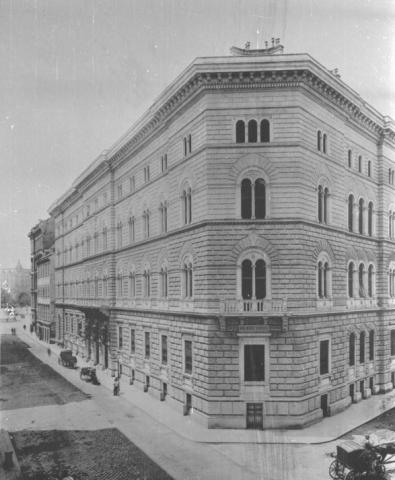The Bodenkreditanstalt building was erected from 1884 to 1887 according to plans by Emil von Förster on behalf of the Allgemeine k. k. private Boden-Credit Anstalt. Because of its size, it had two addresses – Teinfaltstraße 8 and Löwelstraße 20. Following the world economic crisis in 1929, Creditanstalt für Handel und Gewerbe took over what had been the second-largest bank in Austria. The building remained empty at first until 1934, when the Schutzkorpskommando für das Bundesland Wien had its headquarters there. After the annexation of Austria to the Nazi German Reich it was used from 15 March 1938 as an SA barracks. The Industrie- und Handelskammer für Niederdonau (Lower Danube Chamber of Industry and Commerce) had its offices there from 1940, Flugmotorenwerke Ostmark from 1942, and Gauwirtschaftskammer Niederdonau (Lower Danube Gau Economic Chamber) from 1943. From May 1943, the Institut für Denkmalpflege (Institute for Monument Preservation) rented strongrooms in the basement and on the ground floor from Gauwerke Niederdonau, after Ludwig Berg, museum expert in the Generalreferat für Kunstförderung (Department for the Promotion of the Arts) in the Reichsstatthalterei in Vienna, identified it as suitable for storing artworks and had its windows bricked up. In an area of 200 to 300 m² objects from the restoration workshop of the Institut für Denkmalpflege and from secured collections (e.g. classical and East Asian objects from the Lanckoroński collection), paintings and sculptures from the Schottenstift, artworks from the Städtische Sammlungen Wien (e.g. Grillparzer collection), the State Arts and Crafts Museum in Vienna, the Painting Gallery of the Akademie der bildenden Künste (Academy of Fine Arts) and selected works from the Österreichische Galerie and the musical instrument collection of the Kunsthistorisches Museum were all stored separately there. From 1944, private collectors, including Maria Buberl, Hermine Schattenfroh and Josef Pfundner also stored items there. In mid-November 1944 a large quantity of the goods were transported to Altaussee; other transports went to castles in Thürnthal, Schönborn and Waidhofen an der Thaya, which had been repurposed as depots. The storage space was never completely emptied, however.
On 8 May 1945, the artworks belonging to the Schottenstift stored at Löwelstraße 20 were returned to it. In October 1946 the Städtische Sammlungen collected thirty-two crates from it. The Bundesdenkmalamt (BDA) (Federal Monuments Authority) continued to use the strongrooms as a depot, in particular for objects documented as having been expropriated or whose provenance was unknown, including, for example, the artworks in the collection belonging to Wilhelm Freund, which were later auctioned. The BDA took the objects at the depot in St. Marx, which was closed in 1948, to the Bodenkreditanstalt, followed in September 1949 by the objects from Schloss Schönborn and 1951 the artworks from the "former holdings of the Institut für Denkmalpflege" and those stored at the Wollzeile depot until its closure on 22 March 1951. These and the objects that came in June 1961 from the Central Collecting Point Munich were of unknown provenance, i.e. unclaimed or unidentified objects. After the depots in Salzburg and Altaussee were closed in 1963, the objects hitherto stored there were also transferred to Löwelstraße 20. The BDA closed the depot because of the inadequate storage conditions and transported the last crates on 20 January 1967 to the former Mauerbach charterhouse.

